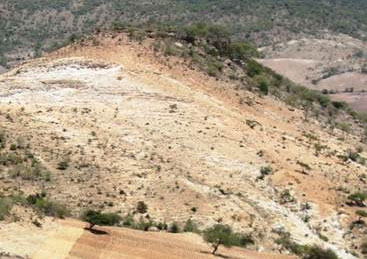VANCOUVER — Applying new exploration models to established mining jurisdictions has long been a hallmark of junior outfits, and Vancouver-based Plata Latina Minerals (TSXV: PAL) is looking to follow suit in Mexico with its “ore-horizon” concept for high-grade epithermal silver deposits.
Plata Latina’s model is based on the research and experience of CEO Michael Clarke, who started working on silver-gold vein formations in Mexico’s prolific San Dimas district in the 1970s. Clarke developed an appreciation for epithermal-style deposits, and wrote his doctorate thesis on the subject at the University of Arizona.
“During my work on these high-grade deposits, it really struck me just how blind these things could be,” Clarke says in a phone interview. “We did a lot of work on fluid inclusions and other variables, and came up with a conclusion that in large part, it had to do with the hydrothermal fluid flow paths and how these things often reach the surface — if at all — in meagre proportions. That seemed to support the observation we had, which was that you could go around and be standing on one of these high-grade deposits, and not see anything.”
Plata Latina’s team studied Mexico’s rich silver belt — which runs over 800 km from the San Dimas district in Durango in the north to near Mexico City in the south — in order to identify prospective projects for an exploration portfolio. According to Clarke, the company began with more than 100 properties, but narrowed it to five: Naranjillo, Vaquerias, Palo Alto, Los Agustinos and La Joya.
“We had our ore-horizon model and combined that with the observation that you get these tremendous high-grade districts that occur in a tight belt,” Clarke says. “We went over a lot of government maps and geophysics, and bought an office in Mexico, which was basically an old Toyota. As you drive between the deposits in the Mexican silver belt you see very little, so we decided to look for areas where you see indications on the surface that could point to an underlying district.”
Plata Latina completed its initial public offering in April 2012, and started with a lot of capital after issuing 6.9 million shares at 50¢ per share, for proceeds of $3.5 million.
The company was ready to kick-start its proof-of-concept drilling and identified its most promising target, which was also permitted for drilling. Clarke says the 307 sq. km Naranjillo property in Guanajuato, Mexico, rose to the top of the list.
“We had the alteration on the surface, which was beautiful stuff, but we really didn’t find any silver during sampling,” Clarke adds. “For the most part it wasn’t even detectable, but that fit into the model we had. It took a bit of courage, but once we saw results from the initial drill program, we felt we’d been successful finding one of these buried projects.”
Over the past year, Plata Latina’s drilling at Naranjillo has unveiled a multi-vein, silver-gold system. The company discovered the Villa vein when hole 10 cut 7.8 metres of 3,181 grams silver per tonne, and 13.29 grams gold per tonne from 585 metres down hole. Subsequent drilling has extended Villa over a 500-metre strike length, with the vein system open to the north and south.
Meanwhile, the nearby Sibila vein was uncovered when hole 2 cut 0.4 metre of 440 grams silver and 3.01 grams gold from 589 metres down hole, while the San Diego vein system was highlighted by hole 32, which intersected 0.2 metre of 594 grams silver and 6.07 grams gold from 654 metres depth.
Plata Latina is wagering that the Villa system may intersect a major structure southwest of its previous collars, which would provide an exploration target, since structural intersections commonly serve as a focal point for silver–gold deposition. So far the company has found silver–gold values on structures over 5 km, along a northwest trend.
“We’re focused on that central area around Villa,” Clarke says. “The area represents a sort of window that measures 4 by 6 km, and exposes pre-mineral rocks. We’ve found those significant silver values and various structures along strike. The basis with the large land package is that we think we’ve found the underlying district, and this window is allowing us to peek through to see what could extend out to even more blind areas to the north and south.”
Plata Latina topped up its coffers with its initial discovery in mid-February, completing a $3.3-million private equity financing, issuing 8.3 million units for 40¢ each. Plata Latina reported $2 million in working capital in June.
Clarke says the company is compiling more data on Naranjillo’s sub-surface geology, and hopes to mobilize drills on the site for a follow-up program by early 2014.
Exploration is also planned at Vaquerias, where preliminary drilling — targeting historic mine workings — cut 0.6 metre at 727 grams silver and 0.24 gram gold from 168 metres depth in hole 4.
Plata Latina shares have traded within a 52-week window of 10¢ to 53¢, and closed at 16¢ at press time.
The company maintains 56 million shares outstanding for a $9-million market capitalization.


Be the first to comment on "Plata Latina aims to uncover Mexico’s next silver district"